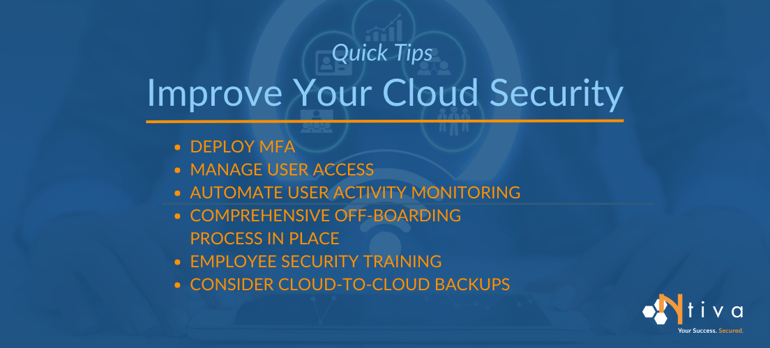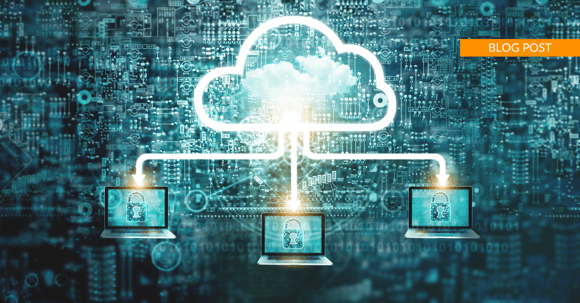These days, it's nearly impossible to find a business that doesn't rely on public cloud services for its essential applications. However, with the increasing frequency of cyberattacks and security breaches on cloud platforms, it's essential to safeguard your cloud apps and data.
Discover how to protect your cloud environment and applications with our top tips for staying secure in the cloud. Keep reading to learn more!
What is Cloud Security?
To safeguard your cloud-based applications and systems, cloud security entails a combination of policies, controls, procedures, and technologies.

As remote work becomes more common, businesses are opting to store their sensitive data in the cloud. It's critical to understand that every business, big or small, has valuable information stored in cloud-based applications, making them vulnerable to cyberattacks.
And as more employees rely on personal and business devices for remote work, companies are at a higher risk of cyber attacks, which can take advantage of vulnerabilities and expand the "attack surface" of a business.
This creates more opportunities for hackers to strike and highlights the importance of mobile device security, especially when accessing cloud apps like Microsoft 365, Google apps and more.
Mobile device security is of particular importance. Many companies may have some sort of monitoring and management in place for corporate-supplied computers, but very few are on top of managing employee-owned mobile devices.
The trend of Bring-Your-Own Device (BYOD) has become increasingly popular among employees who use their personal devices to access cloud applications like Microsoft 365. However, this convenience comes at a cost, as it elevates the risks associated with cloud security.
In a recent advisory, CISA (Cybersecurity and Infrastructure Security Agency) revealed that hackers have been employing successful phishing campaigns and brute force logins to exploit weaknesses in cloud security practices.
Attackers deploy emails with malicious links to try and capture login credentials for cloud service accounts. The emails look legitimate, as do the links, tricking employees with these sophisticated phishing schemes.
Unfortunately, it often comes down to weak cyber hygiene habits in a company that opens the doors to hackers.
How Secure is Cloud Computing?
There's no question that the public cloud service providers you're familiar with, such as Amazon, Google and Microsoft, offer a more secure environment than you could ever hope to with your on-premises servers.
However - even though cloud service providers are terrific when it comes to protecting your data while in the cloud, what they CAN'T protect you from is stolen credentials as mentioned above, or when your company data leaves the cloud to interact with other systems.
The latter happens in every company on a daily basis, as employees access, download and transfer all that data from all sort of devices in all sorts of places to all sorts of people!
Security breaches are rarely caused by poor cloud data security - they're caused by humans. Stolen log-in credentials, disgruntled employees, accidental deletions, insecure wi-fi connections, and other employee mishaps are the reason that your cloud data is at risk.
READ MORE: Why Companies Are Moving to the Cloud
Why is Cloud Security Important?
As more organizations migrate their data, applications and other assets to the cloud, it becomes even more important to understand how to protect this highly sensitive business information that could potentially be exposed.
Preventing leaks and data theft is critical to maintain your customer's trust, not to mention the cost of a data breach, which can easily reach millions of dollars for many companies.
Maintaining regulatory compliance is another reason why cloud security is so important for many industries, who must comply with strict standards or risk huge fines.
For its "2023 Cloud Security Report," Fortinet surveyed IT and security professionals concerning cloud security in their organization.
Amongst the respondents:
- 35% admitted that they're extremely concerned about the security of public cloud or hybrid cloud
- 41% were very concerned
- 23% were moderately or slightly concerned
- Only 1% said they were not at all concerned
Fortunately, there are steps you can take to lower your risk and boost your cloud security. Read on to get the cloud security best practices and strategies you should have in place now!
Establishing a Cloud Security Strategy
There are three main pillars you should focus on when building a cloud security strategy — identity, access, and visibility.
Identity is an essential first step that focuses on determining who needs access to data.
Accurately identifying who should be granted permissions to what allows you to protect your data. Individual employees, software services, and hardware will need to be given access. Identity also involves determining how users will interact with data.
The key to access is using layered security to grant permission to individuals and software services exclusively for the data they need. Layered protection can include network layer access (such as firewalls), IAM access controls, and provider/customer segregation.
Visibility focuses on monitoring and managing data access. With cloud security tools, you can monitor and log how data is being accessed, moved, and shared.
These tools allow you to get a better understanding of how your data is protected and how it’s being used, which is essential to cloud security.
The Nine Best Ways You Can Improve Cloud Security
1. Deploy Multi-Factor Authentication (MFA)
Hackers have numerous ways to gain access to your online business data and applications, but one of the main methods is through stolen credentials. This is why the traditional username and password combination is often inadequate to protect user accounts from cyber attacks.
Once hackers obtain your login information, they gain access to all the cloud-based applications and services vital to your business operations.
Protect all of your cloud users with multi-factor authentication (MFA) to ensure that only authorized personnel can log in to your cloud apps and access that sensitive data in your on- or off- premise environment.
MFA is one of the cheapest yet most effective security controls to keep would-be hackers from accessing your cloud applications.
In fact, most security experts will tell you that it's now considered negligent if you DON'T implement MFA as part of your infrastructure as a service (IAAS) plan.
If you want to learn more about exactly what MFA is, take a look at our data sheet to get all the details.
2. Manage Your User Access to Improve Cloud Computing Security
Most employees don't need access to every application, every piece of information, or every file in your cloud infrastructure.
Setting proper levels of authorization with an IAM plan ensures that each employee can only view or manipulate the applications or data necessary for him or her to do their job.
Assigning access control not only helps prevent an employee from accidentally editing information that he or she isn't authorized to access, but also protects you from hackers who have stolen an employee's credentials.
It should also be noted that many regulatory compliance standards, such as HIPAA, FINRA and many others, require these kinds of security measures.
If an employee who has access to EVERYTHING gets tricked by a phishing email and inadvertently provides their login information to your private cloud - well, now the hacker has the keys to all your kingdoms!
If you don't have the in-house time or talent to manage this user visibility and control yourself, be sure to work with a qualified IT consultant to help you get this set up properly.
You can also explore ongoing management of all your cloud IT services by signing up with a Managed Services Provider who can completely take the burden of user access and management, also known as identity and access management (IAM), off your plate.
3. Restrict Collaborative Access
Restricting collaborative access can help you protect your data from third parties and external security threats. For example, sharing deliverables with a client can present a security risk if that client is then able to access other types of sensitive information.
Using IAM access controls is an essential part of protecting your data from external access. You can assign roles to determine who has permission for different types of data, protecting sensitive information from being viewed by those who shouldn’t have
access.
4. Monitor End-User Activities With Automated Solutions to Detect Intruders
Real-time monitoring and analysis of end-user activities is essential to detect any anomalies or malware that may indicate a breach in your system.
For instance, if someone logs in from an unknown IP address or device, it could be a red flag. Detecting these abnormal activities early on could help prevent hackers from causing mayhem and allow you to identify malware and fix security issues promptly.
There are many SOCaaS solutions that can help you out with this, starting with automated 24/7 networking monitoring and management and moving up to advanced cyber security solutions such as:
- Intrusion Detection & Response
- Vulnerability Scanning and Remediation
- Endpoint Detection and Response
Every business has varying needs for different levels of cyber security services, so be sure to get a third party risk assessment before making any large investments.
5. Distribute Metadata to Prevent Breaches
Metadata provides information about your data, including timestamps, names, and company details. This information can put your organization at risk if it falls into the wrong hands, but metadata is an overlooked aspect of cloud security.
Storage is an issue with metadata, particularly with cloud service providers. Your security checklist for your business should include metadata distribution.
Instead of storing metadata in a central location through your cloud service provider, you can distribute metadata across several locations. This means that, in the event of a breach, only a small portion of your metadata may be accessed.
6. Create a Comprehensive Off-boarding Process to Protect Against Departing Employees
When employees leave your company, make sure they can no longer access your cloud storage, systems, data, customer information, and intellectual properties. This is a crucial security responsibility that often gets pushed back days or weeks after someone has left.
Since each employee would likely have access to many different cloud applications and platforms, you need a systemized deprovisioning process to ensure that all the access rights for each departing employee are revoked.
Again, if you can't manage this internally, don't hesitate to outsource this task to someone who knows how to properly set up, implement and maintain this process.
7. Provide Anti-Phishing Training for Employees on a Regular Basis
.png?width=175&name=Improving%20Cloud%20Security%20Quote(4).png)
Hackers can gain access to secure information by stealing employees' login credentials through social engineering techniques such as phishing, spoofing websites, and social media spying. Cybersecurity has become a shared responsibility.
As an example, the rapid expansion of Microsoft Office 365 has made it a very attractive target for hackers - more and more threats are emerging, specifically the frequency of phishing attacks.
Offering ongoing training is the best way to prevent employees from falling victim to these scams and compromising your company's sensitive data.
Keep in mind we said "ongoing" - phishing training is not one and done, it's a continual process that needs to be managed by someone within the organization in order to make it effective!
8. Consider Cloud-to-Cloud Backup Solutions
As mentioned, the odds of you losing data because of your cloud provider's mistake is very low - but losing that data due to human error is high.
Let's use Microsoft Office 365 as an example.
If an employee should accidentally delete data, a hacker obtains an account password and corrupts the data, or a rogue employee cleans out his inbox and folders - there is nothing Microsoft can do past a certain time period.
Note that most cloud providers, including Microsoft, do store deleted data in their data centers for a short period of time, including your Microsoft Office 365 data.
But be sure to check with your cloud provider to determine what this time frame is, and if there are fees to restore that data (when possible to retrieve it.)
Companies that must abide by strict regulations or are concerned with being held liable due to missing or corrupted data, are turning to cloud-to-cloud backup solutions.
There are many of these cloud IT security solutions on the market today that can help protect you, so check in with a reputable IT consultant to determine which solution is best for your business.
9. Conduct Pen Testing Regularly
Penetration testing is one of the most important parts of cloud security for organizations. The goal of penetration testing is to identify exploitable weaknesses, determine how they impact your business, and test security measures.
There are three different types of penetration testing: black box, gray box, and white box.
You can outsource penetration testing or do it in-house, and the cost will vary accordingly. The cost of penetration testing also depends on the test time, test type, and business size.
With these nine cloud security tips, you can significantly bolster your organization’s resilience in an ever-changing digital landscape.
Cloud Security Threats to Watch For
Protecting your organization means understanding potential cloud security risks. As cloud security and cyber attacks evolve, new threats emerge. Learn more about some of the cloud security threats you need to be vigilant about below.
Internet of Things (IoT) attacks
With the increasing popularity of IoT devices, more organizations and individuals are at risk. Surveillance equipment, sensors, and other devices that connect to your network can create vulnerabilities.
As you adopt this technology, you need to take the potential risks into account.
Sophisticated ransomware
As AI and machine learning improve, cybercriminals may use this technology to develop more sophisticated ransomware attacks. Using more advanced techniques, ransomware attacks can even target healthcare and government organizations.
Mobile exploits
People around the world use mobile devices for things like online banking, sending emails, and managing important accounts through apps. Expect these mobile devices to be a frequent target of cyber attacks through malware and phishing.
Mobile devices that are also connected to your network may present a security risk for the individual as well as your company.
Artificial Intelligence
AI can be used to make attacks more efficient, but it can also be used to automate attacks. As an organization, using AI-powered security tools may be the key to preventing these attacks and responding to threats as quickly as possible to minimize
damage.
When considering how to improve cloud security, keep the above in mind.
Minimize Your Cloud Computing Security Risks
In general, cloud computing is a much more cost-effective option and it's definitely more secure if you take the right precautions.
Following industry best practices in selecting, installing, provisioning, and managing multi-cloud services can help you get the most out of cloud computing, while still maintaining a high level of security to protect your sensitive data.
Experienced IT professionals can help you design and budget for a comprehensive cloud computing strategy that ties all the pieces together, including cloud IT services, and even provide ongoing management to make sure you're protected.
Migrating to the Cloud
If you want to learn more about how migrating to the cloud can optimize your IT infrastructure and security strategy, see our cloud migration services or click below to learn more about cloud migration!
Want to learn more about IT Cloud Services for your business? See Ntiva’s Cloud IT Services.
Cloud Security Managed Services
Virtual Desktop as a Service (DaaS) Provider
Managed Cloud Infrastructure Services (IaaS)





